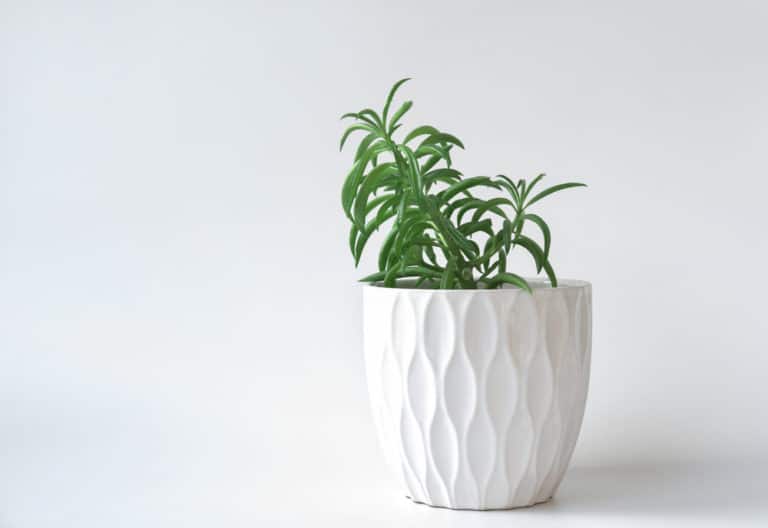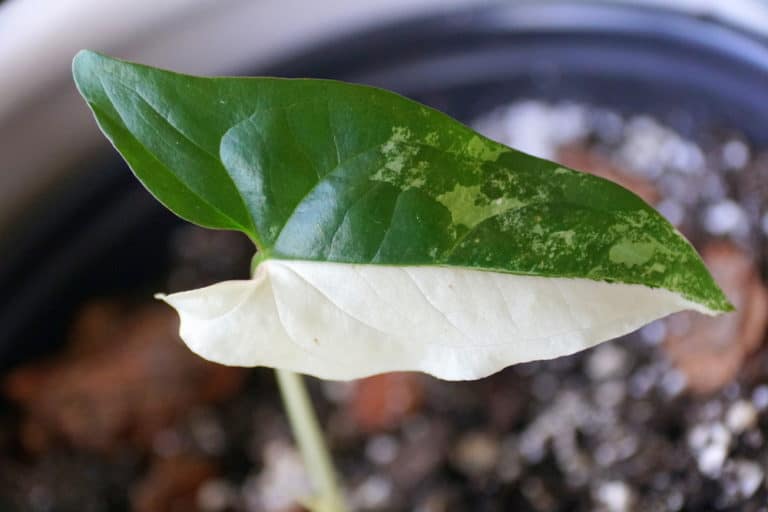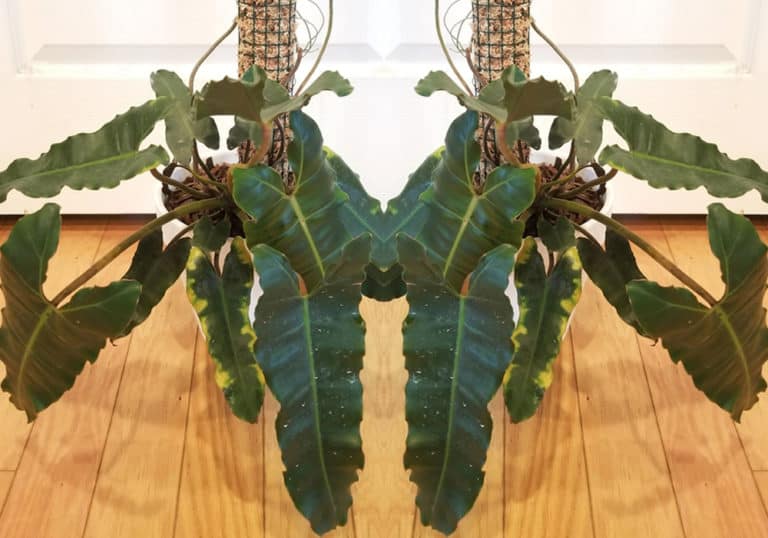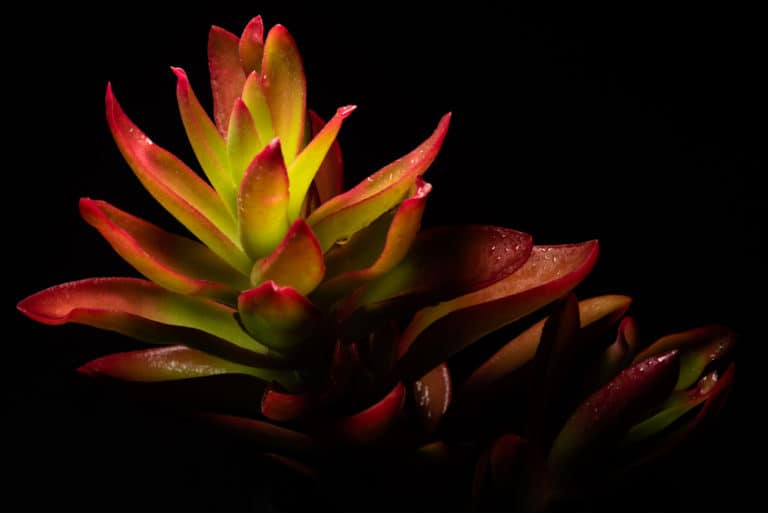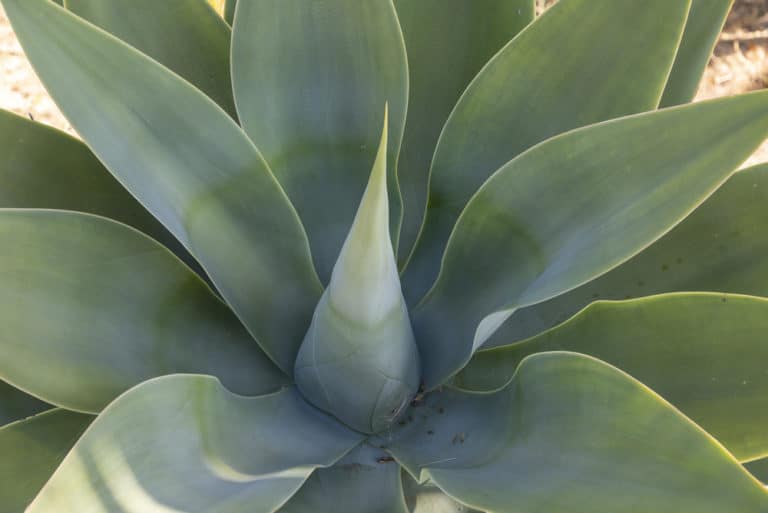Calathea Burle Marx ‘Fishbone Prayer’ Care Guide (2024)
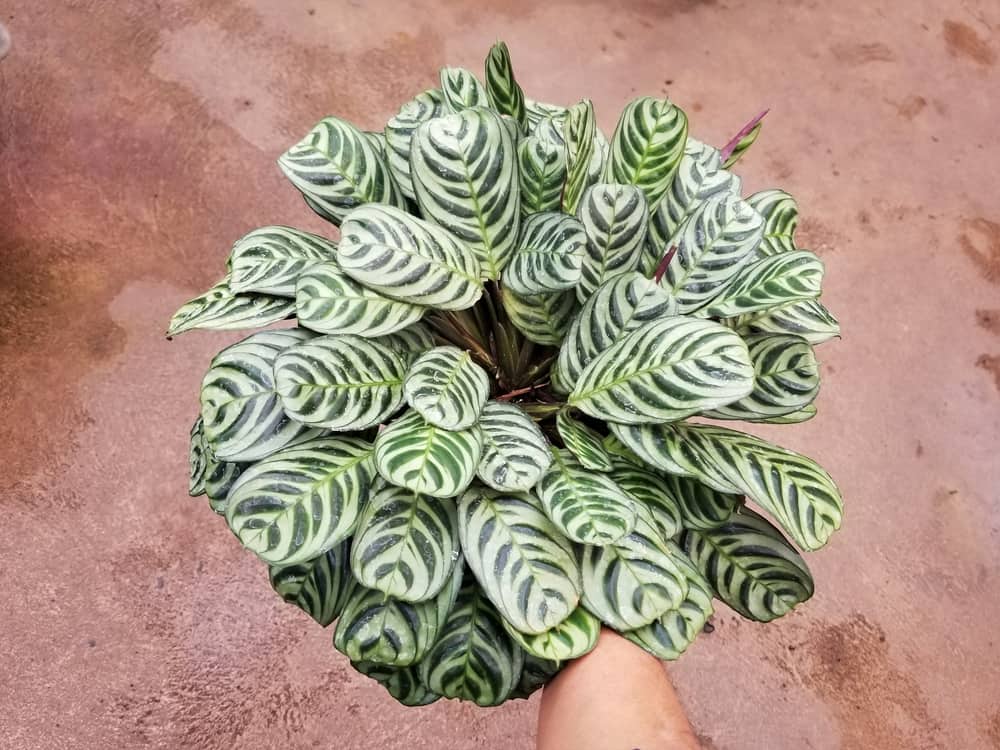
The catchy thing about Calathea burle Marx is the unique pattern on its leaves. It has alternating dark green and light green colors which resemble that of a fishbone. Hence, it’s also known as the fishbone prayer plant. It needs an average level of care and maintenance and is excellent for indoor setups.
| Scientific Name | Ctenanthe burle-marxii |
| Common Name | fishbone prayer plant, blue ice plant |
| Light | bright but indirect sunlight |
| Watering | Keep soil moist during warmer months |
| Temperature | 65°F to 75°F (18°C to 24°C) |
| Hardiness Zone | zones 10 to 12 |
| Humidity | A highly humid environment with at least 60% humidity |
| Soil Type | moist, fertile soil with good drainage |
| Soil pH | between 5.6 and 6.5 |
| Fertilizing | Once a month, balanced houseplant fertilizer during growing season |
| Repotting | Once every 2 years |
| Pruning | Removing the withered leaves and clean dust from the leaves |
| Propagation | Division or offsets in the spring |
| Toxicity | Non – toxic to humans and pets |
| Mature Size | Mature height: 20 inches; Mature width: 10 to 16 inches |
| Bloom Time | winter or early spring |
What’s Unique About Calathea burle marx?
As a member of the Prayer Plant Family, Calathea burle marx plant is also unique in its ability to fold up its leaves during the night. In science, this movement is called nyctinasty, a circadian rhythmic pattern exhibited by plants in response to the onset of darkness.
It is named after a plant enthusiast Sr. Roberto Burle Marx in Brazil where it originates. As prayer plants are popular for their unique and showy variegations, Calathea burle marx has its own pattern to brag. The alternating patterns of the green shades create a pattern of a fishbone on the leaf surface.
Calathea burle marx Care
Calathea burle marx plant care involves the provision of bright but indirect light, high humidity, and moderate watering. Since it’s native to a tropical climate, fishbone prayer plant care pretty much resembles that of tropical plants. Although care and maintenance are not that easy, it’s not that difficult too. Patience is the key.
Light
Proper light conditions are critical to keeping the plant’s variegation vibrant. This plant normally grows under canopies of trees in their natural habitat. Exposure to light shade or bright but indirect light for 8 to 10 days is just perfect. This will satisfy the Calathea burle marx light requirements.
If planted outdoors, we don’t recommend putting it under the full sun all throughout the day. This could harm the plant and leave it scorching. Morning or the late sun will be fine. If indoors, the best spot to achieve your fishbone prayer plant light needs is an eastern facing window.
In times of scarce light sources, you can use grow lights as an alternative.
Watering
You should do Calathea burle marx watering in a moderate manner. This way, you avoid risking your prayer plant to overwatering or underwatering problems. Adjust watering frequency depending on the season with more watering during summer and spring and less during winter.
Water fishbone prayer plant to keep the soil moist but not overly saturated. Make sure that excess water always drains out. This plant has thin and fragile roots that are susceptible to root rot. Be careful not to let the soil dry too before you water again.
Achieving the correct watering needs is one secret to keeping your plant healthy.
Temperature
Calathea burle marx temperature range should go between 65°F to 75°F (18°C to 24°C). As a tropical species, it loves to thrive in warm weather. Its temperature tolerance can even go up to 85 to 90°F (29 to 32°C) without a problem. Avoid freezing temperatures at all costs because they can cause irreversible damage.
US hardiness zones 10 to 12 bear the climate that best is best suited for growing Calathea burle marx. For indoors, avoid placing your plant near drafty locations such as near a door or air conditioner.
Remember that the right temperature for fishbone prayer plant will lead to optimal growth.
Humidity
At least 60% level is the ideal humidity for fishbone prayer plant. Since it lives in the tropical jungle, it naturally loves a moist environment. It can be extra challenging to maintain Calathea burle marx humidity requirements indoors. So, be ready to make an extra effort in misting your plant at least three times a week during the day.
Another tip to increase the humidity level is by using a pebble tray. This method also works whenever you have to leave the house for a long time. You can simply place your plant above it. Just make sure that the bottom won’t be soaked in water.
Soil
There are several amendments that you can combine together to achieve a good mixture of soil for fishbone prayer plant. Such include peat, perlite, coco coir, sand, coconut husks, or orchid bark. These materials would result in a soil mix that has good water retention but at the same time, drains well.
Apart from ensuring good drainage for Calathea burle marx soil, it’s also important to provide sufficient holes in the bottom of the pot. This way, excess water will easily flow out. The correct ph level for fishbone prayer plant is within an acidic range, from 5.6 to 6.5.
Fertilizer
The best time to add Calathea burle marx fertilizer is during its growing seasons which are spring and summer. No need to add fertilizer during winter as the plant is in its resting phase. Use a diluted houseplant fertilizer to supplement the essential nutrients needed for its growth.
Always make sure you use the correct fertilizer ratio in order to avoid overfertilizing. Commercial fertilizers are normally high in salt concentration. If not diluted, they will cause fertilizer burns and will end up damaging the roots.
A good amount of fertilizer for fishbone prayer plant will make it lush and vibrant.
Potting & Repotting
Repotting fishbone prayer plant will have to occur every other year. At this point, your plant may have grown more than enough for its existing pot size to carry. The roots start to show themselves out of the container. Plus, the potting soil is already depleted. Hence, there’s a need for renewal.
The first step to Calathea burle marx repotting is to gently remove the plant from its pot and loosen the soil. Divide the rhizomes into two or three parts. Use a bigger container and replace it with a new potting mix. Pot your plant there and pour in enough water.
Pruning
There’s not much need to conduct Calathea burle marx pruning compared to other bushy plants. But if there are stems that go leggy and out of place, you can trim them off to make them appear more compact. It also helps form the desired shape. Stems with yellow, aged, diseased, or dying leaves are also candidates for pruning.
When cutting fishbone prayer plant, always sterilize the shears that you’re using to avoid the spread of diseases. Make a clean, slanted cut at the base of each stem. This would facilitate fast healing of the wounds created resulting in a healthier plant.
Propagation
When conducting Calathea burle marx propagation, it’s best to make use of the division method. Here, you detach the offsets of the parent plant and pot them in separate pots to grow individually. This is easier, more efficient, and has a higher chance of success. You can do division during repotting in spring.
Other methods also include stem cuttings and air layering. In stem cuttings, you just have to cut size of 2 to 4 inches in length, and let it callous over before planting in a potting media. Air layering is a much more complicated method to propagate fishbone prayer plant.
Also, make sure to check out our in-depth Calathea medallion plant care guide.
Common Problems of Calathea burle marx
There are a few Calathea burle marx problems that you’ll be encountering along the way. Some are quite serious such as diseases but some are manageable. It’s important that you understand how these problems with fishbone prayer plant develop and manifest. Most of the time, the leaves will show symptoms.
Pests
There are two prominent Calathea burle marx pests that you should watch out for. One is the spider mites which often occur during the dry months. They begin to accumulate when the humidity gets lower. Thus, it’s important to maintain the moist air around your fishbone prayer plant through the help of a humidifier or regular misting.
Another pest known as mealybugs are bugs that are waxy in appearance. They look powdery white on the outside. And they leave behind a substance on the leaf surfaces. Once spotted, you can spray horticultural oils to remove them from your Calathea burle marx plants.
Diseases
Fishbone prayer plant can also be susceptible to certain diseases. There are brown leaf tips, drooping leaves, yellowing leaves, and root rot. Brown leaf tips are mostly caused by low humidity, too much light, salt build up on soil, and fertilizer burns. Drooping leaves are a result of incorrect watering and temperature stress.
Yellowing of leaves happens when there’s nutrient deficiency or root rot. On the other hand, root rot can also be a result of poor drainage and overwatering. Dealing with Calathea burle marx diseases is possible by adjusting the environmental conditions to make it more ideal and healthy.
Growing Problems
Pests and diseases aren’t the only growing problems your Calathea burle marx may encounter. There are many stressors that could lead to a sick plant. One particular challenge is incorrect temperature. Every plant needs optimum temperature to grow. They need to accumulate certain levels of heat units to proceed to their developmental stages.
Now, if the climate in your area has a colder temperature, your plant may end up being stunted. Too cold a temperature can slow down plant growth. In this case, it would be best to treat your Calathea burle marx as an indoor plant rather than an outdoor one.
Toxicity of Calathea burle marx
If you’re worried about toxicity, don’t be. We’re lucky that this beautiful Calathea burle marx is a non-toxic plant species. It’s not toxic to pets like cats and dogs, to adult humans and even children. The Fishbone prayer plant is just a perfect indoor plant for families with pets. One you’ll surely love.
For Humans
Humans are spared from any potential toxicity issues. Thanks to this plant’s non-toxic nature. No part of Calathea burle marx is harmful even when ingested. Even the plant sap is not that irritating. However, if you have extra sensitive skin, it’s better to wear gloves when handling.
In the same way, it’s also safe to display this plant around your children. But of course, warm them still not to mess with its foliage. Although it may look inviting, it doesn’t have any palatable taste. Ingesting those gorgeous leaves is not a good idea at all, both for adults and kids.
For Pets
Calathea burle marx is also pet-friendly. That’s good news for those who own cats and dogs at home. You now have another plant species to add to your indoor setup, one that won’t hurt your pets. Since the plant doesn’t have toxic properties, it won’t create any trouble even if your furbabies ingest them.
However, we still recommend putting it away from your pets especially if they’re quite naughty. They might end up playing around with your Calathea burle marx leaving it with damaged leaves. We’ve already heard many horrible stories of pets messing with their parent’s favorite plants. So, let’s be on the safe side.
Calathea burle marx Appearance
A beauty of its own, the Calathea burle marx appearance is something unique in a good way. It has the typical oval-shaped leaves as with other calathea species but carries a peculiar pattern. A Fishbone prayer plant flower is characterized by being white and tiny. Let’s get more details below:
Foliage
The foliage of Calathea burle marx has the most interesting feature. Aside from the fact that it folds up during the night as if it’s praying, it does have beautiful variegation. Its broad leaves have an alternating mark of dark green and light green bands. Those stripes create a fishbone pattern.
The patterns on each leaf get more defined when the plant is subjected to partial shade or bright but indirect light. Prolonged exposure to direct sunlight could result in faded or scorched leaves. Hence, proper lighting will do good for your Calathea plants especially in defining its beautiful variegations.
Flowering
You may notice Calathea burle marx flowering during early spring if planted outdoors. It’s also possible for them to do the same even when it’s taken as an indoor plant. It produces tiny white flowers that are not that noticeable. They appear clustered in a long stalk reaching through the foliage. The size of each flower barely reaches half an inch.
Blooming, however, is not that much of a concern when tending to Calathea plants in general. This is because it’s the leaves that are more attractive and sought after by the gardeners. But the flowers, of course, serve their purpose in pollination.
Size and Growth
As a low-growing plant, the size of Calathea burle marx reaches between 12 to 20 inches in height while about 16 inches in width. It will perfectly match a room with a small area because it won’t consume so much space.
On top of that, it also has a slow growth rate. This plant won’t reach maturity until two full seasons have passed. So, try to be patient and give it time to grow. However, make sure that it receives the best growing conditions as much as possible. This way, your plant will grow healthily and you won’t have to face much trouble.
Calathea burle marx Fragrance
Unfortunately, Calathea burle marx does not possess any special scent. Even though it blooms, the flowers do not produce any fragrance at all. So, there’s nothing much to expect in that area. The plant has a plain smell, nothing too distinctive.
But even though there’s a lack of Calathea burle marx fragrance, this plant compensates with its beauty and extravagant leaves. Forget about fragrance, this plant is enough on its own. It will give your home not only a fresh look but a fresh scent too as this plant purifies the air. It works perfectly in rooms with less ventilation.
Suggested Uses for Calathea burle marx
It would be best to include Calathea burle marx as an ornamental plant indoors. With its lush and attractive foliage, it will surely make an enticing centerpiece on a large table. It would also look good as a corner plant in a partially shaded location. You can mix and match it with other tropical foliage plants too.
Some gardeners use it as a potted plant outdoors to add attraction to a landscape. Others place it in their balconies or terraces. But regardless of how you use it, this fishbone prayer plant will surely make heads turn. So, be ready to receive compliments.
FAQ
What is Calathea burle marx?
Calathea burle marx is a member of the prayer plant family. It’s also called a fishbone prayer plant because of its leaf variegation that resembles the appearance of a fishbone.
How to identify Calathea burle marx?
The beautiful leaves of Calathea burle marx bear a pattern of alternating dark and light green shades. In addition, the shape of each leaf is oval.
How to care for Calathea burle marx?
To keep this plant happy, you must provide it with light shade, moderate watering, high humidity, and warm temperature. These are the basic things you need to achieve.
How to grow Calathea burle marx indoors?
Fishbone prayer plant is best grown indoors provided that you place it in an east-facing window. This location provides the right amount of light that the plant needs.
How to grow Calathea burle marx outdoors?
Place it in a spot that’s partially shaded like a greenhouse. If you don’t have one, just make sure it’s not subjected to full sun for long hours.
How fast does Calathea burle marx grow?
Calathea burle max plant is a slow-growing species. You may have to wait for two seasons to pass before it reaches its full maturity size.
How tall does Calathea burle marx grow?
A mature Calathea burle marx can grow between 12 to 20 inches in height and about 16 inches in width. Its oval-shaped leaves make it appear fuller.
How to make Calathea burle marx grow faster?
Just make sure to provide light shade, enough water, sufficient humidity, and a warm temperature. Adding fertilizer during growing seasons also helps the plant grow lush.
How to stake Calathea burle marx?
You might need a stake to keep your plant upright. Calathea burle marx has some aerial roots so you can use a sphagnum moss pole as support.
How to pot Calathea burle marx?
Use a well-draining potting medium and a medium-sized pot. Make sure it has drainage holes. Plant your Calathea burle marx there and water it sufficiently.
How to revive Calathea burle marx?
Closely inspect what’s the reason behind your plant’s dying. If overwatering, you have to re-pot the plant immediately. If temperature stress, relocate it to a warmer location.
Why is my Calathea burle marx dying?
There can be many causes like too much light, too cold temperature, overwatering, presence of pests and diseases. It can also be a combination of any of these stressors.
Why is my Calathea burle marx drooping?
When leaves are drooping, it’s highly possible that your plant is either overwatered or underwatered. It may also be due to exposure to too much heat.
How cold can Calathea burle marx tolerate?
Calathea burle marx can tolerate as cold as 55oF (13oC). But watch out if it goes lower than this as it can lead to cold stress.
How to get rid of pests on Calathea burle marx?
You can get rid of pests by simply spraying them off using pressurized water. Diluted Neem oil mixed with dishwashing liquid will also work effectively.
Is Calathea burle marx toxic to cats?
No. Calathea burle marx is a friendly plant around your cats. It does not contain any toxic properties that would bring harm even when ingested.
Is Calathea burle marx toxic to dogs?
No. It’s safe for dogs as it’s safe for your cats. There’s no need to worry over potential harm because it has no toxic compounds.
Is Calathea burle marx toxic to children?
Calathea burle marx is also safe for children. However, it is not edible. Hence, you should still warn them not to ingest any part of it.
Is Calathea burle marx toxic to humans?
No. This plant is all safe for human handling. However, we still recommend using protective gloves to avoid skin irritation. Don’t ingest the plant either.
Does Calathea burle marx have a scent?
None. Regardless of its extravagant beauty, this plant has no special scent. Not the foliage nor the flowers produce fragrance. Just enjoy it for its variegations.

